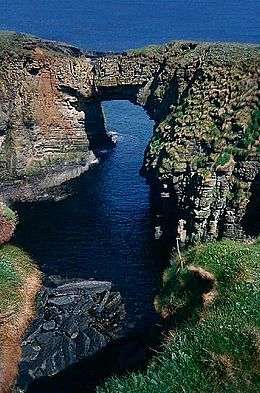Sea Mither

Sea Mither, or Mither of the Sea, is a mythical being of Orcadian folklore that lives in the sea during summer, when she confines the demonic nuckelavee to the ocean depths. Each spring she battles with her arch-enemy Teran, another spirit of Orcadian legend capable of causing severe winter storms, to gain control of the seas and the weather. Eventually Sea Mither overcomes Teran and sends him to the depths of the ocean, but the effort of keeping him confined there along with her other benevolent labours during the summer exhaust her, until in the autumn Teran takes advantage of her weakness to wrest control from her once again.
Stories of the Sea Mither and Teran are among Orkney's oldest legends, perhaps invented to explain the vagaries of weather and other naturally occurring events. In Shetland fishermen petition Sea Mither to afford them protection from the Devil.
Etymology
Mither is defined in the Dictionary of the Older Scottish Tongue as the Scots variant of "mother",[1] which may particularly reflect oral Orcadian use.[2] The name of her opponent, Teran, is local Orkney dialect meaning "furious anger",[3] and may be a derivative of tyrren, Norse for "angry".[2]
Folk beliefs
Description and common attributes
Sea Mither is a spirit of summer days that quells the turbulent sea waters around the northern isles of Scotland.[4] Shetland islanders, particularly fishermen, seek her protection from the Devil.[5] Control of the seas is maintained by Teran, the spirit of winter, until Sea Mither arrives around the time of the vernal equinox in mid-March.[3] Both spirits are invisible to humans.[6] Teran is her arch-enemy and the pair fight bitterly, often for weeks as she tries to gain control.[3] Their arguments cause gale force winds and heavy tumultuous seas as she tries to wrest control from him.[3] Teran's screeches are carried by the howling gales as the two spirits try to oust each other.[4] The period of the spring combat between the pair is termed the Vore tullye or the "spring struggle".[3] Eventually Sea Mither overcomes Teran, relegating him to the depths of the ocean;[7] inclement summer weather is caused by Teran's attempts to escape.[7]
During summer months the Sea Mither also keeps the demonic nuckelavee creature confined,[8] and undertakes benevolent labours: she empowers aquatic creatures with the ability to reproduce;[6] warms and calms the seas;[4] and instils a softer song-like quality to the gentle summer breeze.[6] According to folklorist and Orkney resident, Walter Traill Dennison, during Sea Mither's reign in summer the conditions reported by islanders may have "tempted one to believe that the Orkney archipelago had become the islands of the blessed."[6] But the continual work she undertakes to keep everything calm and the strain of maintaining control over Teran gradually tires her.[6]
As autumn approaches, Teran takes advantage of Sea Mither's exhaustion to break free, and conflict between the two starts again.[6] The power struggles cause the weather to change with darkening skies and howling winds.[7] This time, Teran triumphs in the conflict termed the Gore vellye.[6][lower-alpha 1] Control of the ocean and weather is returned to Teran and Sea Mither is forced to leave.[7] No details are given as to where she spends the winter, but during the storms caused by Teran the fishermen were consoled that Sea Mither would return refreshed and powerful in the spring, to again oust Teran from his malevolent grip over the seas.[9]
Origins
Orcadian tales were strongly influenced by Scandinavian mythology with a blending of traditional Celtic stories.[10] Folklorist and writer Ernest Marwick describes the Sea Mither and Teran as "pure personifications of nature."[4] Several ancient myths were based upon the natural elements of the turbulent and ever changing sea surrounding Orkney,[11] but the stories of the two spirits are among the oldest legends on the islands.[4] People had to be able to explain the vagaries of weather and other natural life cycles without the benefit of science; Traill Dennison hypothesises that this is why "the imagination of some half savage" may have formed the foundations of the myth.[3]
References
Notes
Citations
- ↑ "mither, n", Dictionary of the Scots Language (online ed.), retrieved 29 July 2014
- 1 2 "The Mither o' the Sea", Orkneyjar.com, archived from the original on 29 July 2014, retrieved 29 July 2014
- 1 2 3 4 5 6 Traill Dennison (1890), p. 70
- 1 2 3 4 5 Marwick (2000), p. 19
- ↑ Marwick (2000), p. 23
- 1 2 3 4 5 6 7 8 Traill Dennison (1890), p. 71
- 1 2 3 4 5 Marwick (2000), p. 20
- ↑ Traill Dennison (1891), p. 131
- ↑ Marwick (2000), p. 71
- ↑ Muir (2014), p. 10
- ↑ "The Sea in Orkney Folklore", archived from the original on 26 June 2014, retrieved 31 July 2014
Bibliography
- Marwick, Ernest W. (2000) [1975], The Folklore of Orkney and Shetland, Birlinn, ISBN 978-1-84158-048-7
- Muir, Tom (2014), Orkney Folk Tales, History Press, ISBN 978-0-7509-5533-1
- Traill Dennison, Walter (1890), "Orkney Folklore, Sea Myths", The Scottish Antiquary, or, Northern Notes and Queries, Edinburgh University Press, 5 (18), JSTOR 25516326, (subscription required (help))
- Traill Dennison, Walter (1891), "Orkney Folklore, Sea Myths", The Scottish Antiquary, or, Northern Notes and Queries, Edinburgh University Press, 5 (19), JSTOR 25516359, (subscription required (help))